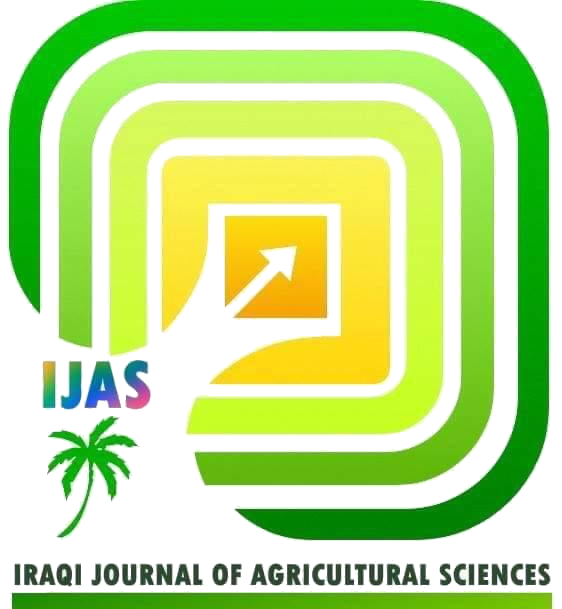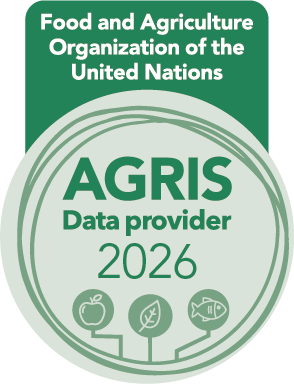ENHANCING OF CANDIDA TROPICALIS AND THEIR POTENTIAL ON VEGETABLE SOYBEAN CV. CHIANG MAI 84-2 GROWTH AND YIELD AS INOCULANT BIOFERTILIZER
DOI:
https://doi.org/10.36103/06qvnm20Keywords:
auxin, economic yield, green bean, phosphate solubilizing fungi, phosphorusAbstract
Since phosphorus (P) is lower in agricultural areas with acid sandy soil, it runs out in different parts of crop plants after harvesting. To boost growth and development in the next cropping system, only overuse of inorganic phosphate fertilizers can adversely affect agricultural sustainability. Phosphate-solubilizing fungi like Candida tropicalis play a role in plant P nutrition through soil P dynamics and growth hormones. Three PSF isolates (Sw01, Pu02, and Pu04) from bulk soil of fresh corn were tested for optimal media and incubation times. The results showed that Sw01 produced the highest population of 593.33×10⁸CFU L⁻¹ when cultured in TB media after five days. These PSFs were used to investigate the potential of C. tropicalis on yield components, chlorophyll pigments, and nutritional value of vegetable soybean cv. Chiang Mai 84-2. The result demonstrated that applying 50% inorganic fertilizer mixed with C. tropicalis enhanced leaf area, root length at the vegetative stage, and chlorophyll a and total chlorophyll contents at the flowering and harvest stage. This application increased pod fresh weight to 11,214 kg ha⁻¹, with an average of 28 pods plant⁻¹ and 47.50 seeds plant⁻¹ compared to fertilizer managements.
References
1. Agamy, R., M. Hashem and S. Alamri . 2013. Effffect of soil amendment with yeasts as bio-fertilizers on the growth and productivity of sugar beet. African Journal of. Agricultural Research. 8:46-56.
2. Amprayna, K., M.T. Rosea, M. Kecskés, L. Pereg, H.T. Nguyend, and I.R. Kennedy. 2012. Plant growth promoting characteristics of soil yeast (Candida tropicalis HY) and its effectiveness for promoting rice growth. Applied Soil Ecology. 61:295-299.
3. Arnon, D.I. 1949. Copper enzymes in isolated chloroplasts. Polyphenoloxidase in Beta vulgaris. Plant Physiology. 24:1-15.
4. Al-jubouri, K. D. H., I. J. Abdul Rasool, A. M.H. H. Al-Khafaji, A. J. Abdulsada, F. Y. Baktash, W. H. Hasoon, and Z. J. Al-Mousawi. 2025. Unraveling prolonged irrigation intervals and some sustainable treatments on potato starch composition, growth, and productivity in iraq. Iraqi Journal of Agricultural Sciences, 56(1), 321-329.
https://doi.org/10.36103/s9q1w418
5. Al-Khafaji, A. M.H. H., K. D. H. Al-jubouri, F. Y. Baktash, I. J. Abdul Rasool, and Z. J. Al-Mousawi. 2024. Amelioration potato plant performance under drought conditions in Iraq by using titanium dioxide, and biodegrading, biodegradable treatments. Iraqi Journal of Agricultural Sciences, 55(6), 1885-1893.
https://doi.org/10.36103/03fway21
6. Aldolaimy, O. M. S., H. A. Abdul- Ratha, and B. K. Abduljabar. 2024. Effect of bio-organic and mineral fertilization, on the growth and yield of cauliflower (Brassica oleraceae var.botrytis). Iraqi Journal of Agricultural Sciences –55(5):1667-1675.
https://doi.org/10.36103/pt592r56
7. Al-Silmawy, N. A. J. K., and H. A. Abdul-Ratha. 2023. Effect of biofertilizer, vermicompost and phosphate fertilizer on growth and yield of cauliflower (Brassica oleraceae Var. botrytis). Iraqi Journal of Agricultural Sciences. 54(2): 505- 515. https://doi.org/10.36103/ijas.v54i2.1726
8. Baqir, H. A., M.F.H. AL-hassan, and J. W. Mahmood. 2024. Role of bio health extract on wheat growth according to Zadoks decimal scale. Res. Crop. 25 (4): 547-552. DOI: 10.31830/2348-7542.2024.ROC-1130
9. Bajracharya, D. 1999. Experiments in plant physiology: A laboratory manual. New Delhi, India: Norasa Publishing House.
10. Bononi, L., J.B. Chiaramonte, C.C. Pansa, M.A. Moitinho and I.S. Melo. 2020. Phosphorus-solubilizing Trichoderma spp. from Amazon soils improve soybean plant growth. Scientific Reports. 10.
11. Brisson V.L, J. Richardy, S. M. Kosina, T. R. Northen, J. P. Vogel, and A. C. M. Gaudin 2022. Phosphate availability modulates root exudate composition and rhizosphere microbial community in a teosinte and a modern maize cultivar. Phytobiomes Journal. 6:83-94.
12. Chen, Y.P., P.D. Rekha, A.B. Arun, F.T. Shen, W.A. Lai, and C.C. Young. 2006. Phosphate solubilizing bacteria from subtropical soil and their tricalcium phosphate solubilizing abilities. Applied Soil Ecology. 34:33-41.
13. Cong, P.T., T.D. Dung, T.M. Hien, N.T. Hien, A.T.M.A. Choudhury, M.L. Kecskés and I.R. Kennedy. 2009. Inoculant plant growth-promoting microorganisms enhance utilisation of urea-N and grain yield of paddy rice in southern Vietnam. Eur. Soil Biology and Biochemistry. (45), 52-61.
14. Cruz, R.C., S.M.C. Werneck, C.S. Oliveira, P.C. Santos, B.M. Soares, D.A. Santos, and P.S. Cisalpino. 2013. Influence of different media, incubation times, and temperatures for determining the MICs of seven antifungal agents again-st Paracoccidioides brasiliensis by microdil-ution. Journal of Clinical Microbiology. 51:436-443.
15. Dheyab S., N., A M.H. H. Al-Khafaji, I. J. Abdul Rasool, K. D. H. Al-jubouri, F. Y. Baktash, Z. J. Al-Mousawi, and D. A. Hanoon. 2025. Reducing water consumption and improving soil, root quality of potato via environmentally sustainable treatments. Iraqi Journal of Agricultural Sciences, 55(special):1-9. https://doi.org/10.36103/przef771
16. Francis, B., C.T. Aravindakumar, P.B. Brewer, and S. Simon. 2023. Plant nutrient stress adaptation: A prospect for fertilizer limited agriculture. Environmental and Experimental Botany. 213:105431.
17. Gomaa, A., S. Moawad, I. Ebadah and H. Salim. 2005. Application of bio-organic farming and its inflfluence on certain pests infestation, growth and productivity of potato plants. Journal of Applied Sciences Research. 1:205-211.
18. Haridy, M.S., G.K.A. El-Baki, E.N. Fawzy. 2022. Potentiality of some yeast species for promotion of growth and productivity of soybean plants (Glycine max L.). Journal of Advanced Biomedical and Pharmaceutical Sciences. 5:64-78.
19. Kecskés, M.L., M.T. Rose, C.T.T. Kim, O.N. Kim, E. Michel, B. Lauby, M. Rakotondrainibe, A.V. Casteriano, A. Palágyi, G. Krishnen and I.R. Kennedy. 2008. Identifification and quality control of BioGro inoculant biofertiliser strains. In: Kennedy, I.R., A.T.M.A. Choudhury, M.L. Kecskés, M.T. Rose, (Eds.), Proceedings of a Project (SMCN/2002/073) Workshop Held in Hanoi Vietnam. ACIAR Proceedings (130). Canberra, pp. 117-125.
20. Khunpilueg, P., A. Chotiyarnwong, P. Chotiyarnwong, V. Tepjun, J. Phoomthaisong, N. Wanasai, A. Kasiwiwat, and A. Maliphun. 2012. A new aroma vegetable soybean “Chiang Mai 84-2”. Chiang Mai Field Crops Research Center (CMFCRC).
21. Kim, I.S. 2021. Current perspectives on the beneficial effects of soybean isoflavones and their metabolites for humans. Antioxidants. 10:1064.
22. Lacaz, C.S. 1994. Paracoccidioides brasiliensis: morphology, evolutionary cycle; maintenance during saprophytic life; biology, virulence, taxonomy. CRC Press. 13-25.
23. Mardamootoo, T., C.C.D. Preez and J.H. Barnard. 2021. Agricultural phosphorus management for environmental protection: a review. Journal of Geoscience and Environment Protection. 9:48-81.
24. Mekki, B.B and A.G. Ahmed. 2005. Growth, yield and seed quality of soybean (Glycine max L.) as affected by organic, biofertilizer and yeast application. Research Journal of Agriculture and Biological Sciences. (1), 320324.
25. Millipore. 2018. Culture media for industrial microbiology. Darmstadt, Germany. Available online: www.sigmaaldrich.com. (Accessed on March 4, 2024).
26. Nair, R.M., V.N. Boddepalli, M.R. Yan, V. Kumar, B. Gill, R.S. Pan, C. Wang, G.L. Hartman, R.S. Souza and P. Somta. 2023. Global status of vegetable soybean. Plants. 12:609.
27. Otlewska, A., M. Migliore, K. Dybka-Stepien, A. Manfredini, K. Struszczyk-Swita, R. Napoli, A. Białkowska, L. Canfora, and F. Pinzari. 2020. When salt meddles between plant, soil, and microorganisms. Frontiers in Plant Science. 11:1-23.
28. Pradhan, S.N., A. Patra and T. Behera. 2020. Phosphorus: an ultimate limiting soil nutrient. Food and Scientific Reports. 1:31-42.
29. Puppala, K.R., T. Naik, A. Shaik, S. Dastager, R.V. Kumar, J. Khire and M. Dharne. 2018. Evaluation of Candida tropicalis (NCIM 3321) extracellular phytase having plant growth promoting potential and process development
30. Puri, A., K.P. Padda, and C.P. Chanway. 2020. In vitro and in vivo analyses of plant growth promoting potential of bacteria naturally associated with spruce trees growing on nutrient-poor soils. Applied Soil Ecology. 149:103538.
31. Rafiquen, M., T. Sultan, I. Ortas, H.J. Chaudhary. 2017. Enhancement of maize plant growth with inoculation of phosphate-solubilizing bacteria and biochar amendment in soil. Soil Science and Plant Nutrition. 63:460-469.
32. Shahid, M.Q., M.F. Saleem, H.Z. Khan, and S.A. Anjum. 2009. Performance of soybean (Glycine max L.) under different phosphorus levels and inoculation. Pakistan Journal of Agricultural. 46.
33. Shome, S., A. Barman, Z.M. Solaiman. 2022. Rhizobium and phosphate solubilizing bacteria influence the soil nutrient availability, growth, yield, and quality of soybean. Agriculture. 12:1-18.
34. Singh, D.P., V. Singh, V.K. Gupta, R. Shukla, R. Prabha, B.K. Sarma, and J.S. Patel. 2020. Microbial inoculation in rice regulates antioxidative reactions and defense related genes to mitigate drought stress. Scientific Reports. 10:4818.
35. Somdee, T., U. Mahaweerawat, J. Wibulutai, N. Dungkokruad, and S. Yungyuen. 2017. Polyphenol contents, antioxidant and anticancer activity (MCF-7) of soybean products in Thailand. Chiang Mai Journal of Science. 44:176-183.
36. Song, M., X. Wang, H. Xu, X. Zhou4 and C. Mu. 2023. Efect of Trichoderma viride on insoluble phosphorus absorption ability and growth of Melilotus ofcinalis. Scientifc Reports. 13:12345.
37. Statistix10. 2013. Analytical software user’s manual. Tallahassee, Florida. Available online: https://www.statistix.com/. (Accessed on March 2, 2024).
38. Tartoff, K.D., and C.A. Hobbs. 1987. Improved media for growing plasmid and cosmid clones. Bethesda Research Laboratories. 9:12.
39. Uzma, F., C.D. Mohan, A. Hashem, N.M. Konappa, S. Rangappa, P.V. Kamath, B.P. Singh, V. Mudili, V.K. Gupta, C.N. Siddaiah, S. Chowdappa, A.A. Alqarawi, and E.F.A. Allah. 2018. Endophytic fungi alternative sources of cytotoxic compounds: a review. Frontiers in Pharmacology. 9:309.
40. Vassileva, M., G.D.O. Mendes, M.A. Deriu, G.D. Benedetto, E. Flor-Peregrin, S. Mocali, V. Martos, and N. Vassilev. 2020. Fungi, P-solubilization and plant nutrition. Microorganisms. 10:1716.
41. Verma, P., A.N. Yadav, V. Kumar, D.P. Singh, and A.K. Saxena. 2017. Role of phosphate-solubilizing fungi in improving plant nutrient uptake and crop quality. Department of Microbiology, Akal College of Basic Sciences, Eternal University, Sirmour, India.
42. Wahid, F., M. Sharif, S. Steinkellner, A. Khan, M. Marwat, and S. Khan. 2016. Inoculation of arbuscular mycorrhizal fungi and phosphate solubilizing bacteria in the presence of rock phosphate improves phosphorus uptake and growth of maize. Pakistan Journal of Botany. 48:739-747.
43. Wang, H., J. Guo, X. Chen, and H. He. 2023. The metabolomics changes in Luria-Bertani broth medium under different sterilization methods and their effects on Bacillus growth. Metabolites. 13:958.
44. Xu, X.L., X.L. Mao, L.V. Zwieten, N.K. Niazi, K. Lu, and N.S. Bolan. 2020. Wetting-drying cycles during a rice-wheat crop rotation rapidly (im) mobilize recalcitrant soil phosphorus. Journal of Soils and Sediments. 20:3921-3930.
45. Zahid, M., M.K. Abbasi, S. Hameed and N. Rahim. 2015. Isolation and identification of indigenous plant growth promoting rhizobacteria from Himalayan region of Kashmir and their effect on improving growth and nutrient contents of maize (Zea mays L.). Frontiers in Microbiology. 6:1-15.
46. Zhenghai Zhang, Ning Liu, Cai Shao, Hai Sun, Zhengbo Liu, Yiming Guan, Lianju Wu, Linlin Zhang, Xiaoxi Pan, Yayu Zhang, Bing Zhang.2020. Arbuscular mycorrhizal fungi biofertilizer improves American ginseng (Panax quinquefolius L.) growth under the continuous cropping regime, Geoderma, 363,114155, https://doi.org/10.1016/j.geoderma.2019.114155
47. Zhu, J., J., Wu, Z. Shi, et al. 2022.Taxonomic response of bacterial and fungal populations to biofertilizers applied to soil or substrate in greenhouse-grown cucumber. Sci Rep 12, 18522. https://doi.org/10.1038/s41598-022-22673-4
48. Zhengyang, Liu, Wang, Y., Hao, X. et al. 2023. Biodiversity of the beneficial soil-borne fungi steered by Trichoderma-amended biofertilizers stimulates plant production. npj Biofilms Microbiomes 9, 46 . https://doi.org/10.1038/s41522-023-00416-1
49. Xue Han, Yulong Li, Haiyang Li, Gang Han, Jiao Xi, Yutao Liu, Yanjiang Zhang, Quanhong Xue, Qiao Guo, and Hangxian Lai. 2022. Actinobacterial biofertilizer improves the yields of different plants and alters the assembly processes of rhizosphere microbial communities. Applied Soil Ecology, 171, 104345. https://doi.org/10.1016/j.apsoil.2021.104345
50. Žaklina Karaklajić-Stajić, Arijana Pešaković, Slobodan Milenković, and Olga Mitrović. 2013. Biofertilizer affecting yield related characteristics of strawberry (Fragaria×ananassa Duch.) and soil micro-organisms. Scientia Horticulturae,150:238-243, https://doi.org/10.1016/j.scienta.2012.11.016
Downloads
Published
Issue
Section
License
Copyright (c) 2025 IRAQI JOURNAL OF AGRICULTURAL SCIENCES

This work is licensed under a Creative Commons Attribution-NonCommercial-NoDerivatives 4.0 International License.

2.jpg)


